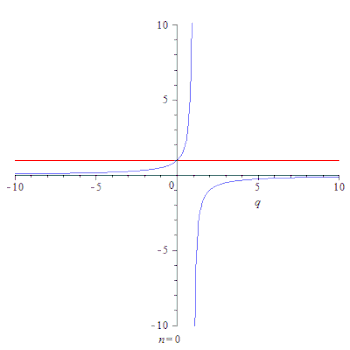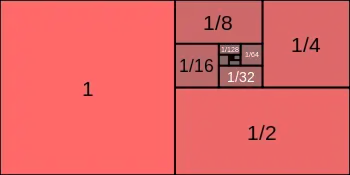Geometric progression
In mathematics, a geometric progression, also known as a geometric sequence, is a sequence of non-zero numbers where each term after the first is found by multiplying the previous one by a fixed, non-zero number called the common ratio. For example, the sequence 2, 6, 18, 54, ... is a geometric progression with common ratio 3. Similarly 10, 5, 2.5, 1.25, ... is a geometric sequence with common ratio 1/2.

Examples of a geometric sequence are powers rk of a fixed non-zero number r, such as 2k and 3k. The general form of a geometric sequence is
where r ≠ 0 is the common ratio and a ≠ 0 is a scale factor, equal to the sequence's start value.
The distinction between a progression and a series is that a progression is a sequence, whereas a series is a sum.
Elementary properties
The n-th term of a geometric sequence with initial value a = a1 and common ratio r is given by
and in general
Such a geometric sequence also follows the recursive relation
- for every integer
Generally, to check whether a given sequence is geometric, one simply checks whether successive entries in the sequence all have the same ratio.
The common ratio of a geometric sequence may be negative, resulting in an alternating sequence, with numbers alternating between positive and negative. For instance
- 1, −3, 9, −27, 81, −243, ...
is a geometric sequence with common ratio −3.
The behaviour of a geometric sequence depends on the value of the common ratio.
If the common ratio is:
- positive, the terms will all be the same sign as the initial term.
- negative, the terms will alternate between positive and negative.
- greater than 1, there will be exponential growth towards positive or negative infinity (depending on the sign of the initial term).
- 1, the progression is a constant sequence.
- between −1 and 1 but not zero, there will be exponential decay towards zero (→ 0).
- −1, the absolute value of each term in the sequence is constant and terms alternate in sign.
- less than −1, for the absolute values there is exponential growth towards (unsigned) infinity, due to the alternating sign.
Geometric sequences (with common ratio not equal to −1, 1 or 0) show exponential growth or exponential decay, as opposed to the linear growth (or decline) of an arithmetic progression such as 4, 15, 26, 37, 48, … (with common difference 11). This result was taken by T.R. Malthus as the mathematical foundation of his Principle of Population. Note that the two kinds of progression are related: exponentiating each term of an arithmetic progression yields a geometric progression, while taking the logarithm of each term in a geometric progression with a positive common ratio yields an arithmetic progression.
An interesting result of the definition of the geometric progression is that any three consecutive terms a, b and c will satisfy the following equation:
where b is considered to be the geometric mean between a and c.
Geometric series
| 2 | + | 10 | + | 50 | + | 250 | = | 312 | |||
| − ( | 10 | + | 50 | + | 250 | + | 1250 | = | 5 × 312 ) | ||
| 2 | − | 1250 | = | (1 − 5) × 312 | |||||||
Computation of the sum 2 + 10 + 50 + 250. The sequence is multiplied term by term by 5, and then subtracted from the original sequence. Two terms remain: the first term, a, and the term one beyond the last, or arm. The desired result, 312, is found by subtracting these two terms and dividing by 1 − 5.
A geometric series is the sum of the numbers in a geometric progression. For example:
Letting a be the first term (here 2), n be the number of terms (here 4), and r be the constant that each term is multiplied by to get the next term (here 5), the sum is given by:
In the example above, this gives:
The formula works for any real numbers a and r (except r = 1, which results in a division by zero). For example:
Since the derivation (below) does not depend on a and r being real, it holds for complex numbers as well.
Derivation
To derive this formula, first write a general geometric series as:
We can find a simpler formula for this sum by multiplying both sides of the above equation by 1 − r, and we'll see that
since all the other terms cancel. If r ≠ 1, we can rearrange the above to get the convenient formula for a geometric series that computes the sum of n terms:
Related formulas
If one were to begin the sum not from k=1 or 0 but from a different value, say , then
Differentiating this formula with respect to allows us to arrive at formulae for sums of the form
For example:
For a geometric series containing only even powers of multiply by :
Equivalently, take as the common ratio and use the standard formulation.
For a series with only odd powers of ,
An exact formula for the generalized sum when is expanded by the Stirling numbers of the second kind as [1]
Infinite geometric series
An infinite geometric series is an infinite series whose successive terms have a common ratio. Such a series converges if and only if the absolute value of the common ratio is less than one (|r| < 1). Its value can then be computed from the finite sum formula


Since:
Then:
For a series containing only even powers of ,
and for odd powers only,
In cases where the sum does not start at k = 0,
The formulae given above are valid only for |r| < 1. The latter formula is valid in every Banach algebra, as long as the norm of r is less than one, and also in the field of p-adic numbers if |r|p < 1. As in the case for a finite sum, we can differentiate to calculate formulae for related sums. For example,
This formula only works for |r| < 1 as well. From this, it follows that, for |r| < 1,
Also, the infinite series 1/2 + 1/4 + 1/8 + 1/16 + ⋯ is an elementary example of a series that converges absolutely.
It is a geometric series whose first term is 1/2 and whose common ratio is 1/2, so its sum is
The inverse of the above series is 1/2 − 1/4 + 1/8 − 1/16 + ⋯ is a simple example of an alternating series that converges absolutely.
It is a geometric series whose first term is 1/2 and whose common ratio is −1/2, so its sum is
Complex numbers
The summation formula for geometric series remains valid even when the common ratio is a complex number. In this case the condition that the absolute value of r be less than 1 becomes that the modulus of r be less than 1. It is possible to calculate the sums of some non-obvious geometric series. For example, consider the proposition
The proof of this comes from the fact that
which is a consequence of Euler's formula. Substituting this into the original series gives
- .
This is the difference of two geometric series, and so it is a straightforward application of the formula for infinite geometric series that completes the proof.
Product
The product of a geometric progression is the product of all terms. It can be quickly computed by taking the geometric mean of the progression's first and last individual terms, and raising that mean to the power given by the number of terms. (This is very similar to the formula for the sum of terms of an arithmetic sequence: take the arithmetic mean of the first and last individual terms, and multiply by the number of terms.)
As the geometric mean of two numbers equals the square root of their product, the product of a geometric progression is:
- .
(An interesting aspect of this formula is that, even though it involves taking the square root of a potentially-odd power of a potentially-negative r, it cannot produce a complex result if neither a nor r has an imaginary part. It is possible, should r be negative and n be odd, for the square root to be taken of a negative intermediate result, causing a subsequent intermediate result to be an imaginary number. However, an imaginary intermediate formed in that way will soon afterwards be raised to the power of , which must be an even number because n by itself was odd; thus, the final result of the calculation may plausibly be an odd number, but it could never be an imaginary one.)
Proof
Let P represent the product. By definition, one calculates it by explicitly multiplying each individual term together. Written out in full,
- .
Carrying out the multiplications and gathering like terms,
- .
The exponent of r is the sum of an arithmetic sequence. Substituting the formula for that calculation,
- ,
which enables simplifying the expression to
- .
Rewriting a as ,
- ,
which concludes the proof.
History
A clay tablet from the Early Dynastic Period in Mesopotamia, MS 3047, contains a geometric progression with base 3 and multiplier 1/2. It has been suggested to be Sumerian, from the city of Shuruppak. It is the only known record of a geometric progression from before the time of Babylonian mathematics.[2]
Books VIII and IX of Euclid's Elements analyzes geometric progressions (such as the powers of two, see the article for details) and give several of their properties.[3]
See also
- Arithmetic progression – Sequence of numbers
- Arithmetico-geometric sequence – Mathematical sequence satisfying a specific pattern
- Linear difference equation
- Exponential function – Mathematical function, denoted exp(x) or e^x
- Harmonic progression – Progression formed by taking the reciprocals of an arithmetic progression
- Harmonic series – Divergent sum of all positive unit fractions
- Infinite series – Infinite sum
- Preferred number – Standard guidelines for choosing exact product dimensions within a given set of constraints
- Thomas Robert Malthus – British political economist (1766–1834)
- Geometric distribution – Probability distribution
References
- "Set Partitions: Stirling Numbers". Digital Library of Mathematical Functions. Retrieved 24 May 2018.
- Friberg, Jöran (2007). "MS 3047: An Old Sumerian Metro-Mathematical Table Text". In Friberg, Jöran (ed.). A remarkable collection of Babylonian mathematical texts. Sources and Studies in the History of Mathematics and Physical Sciences. New York: Springer. pp. 150–153. doi:10.1007/978-0-387-48977-3. ISBN 978-0-387-34543-7. MR 2333050.
- Heath, Thomas L. (1956). The Thirteen Books of Euclid's Elements (2nd ed. [Facsimile. Original publication: Cambridge University Press, 1925] ed.). New York: Dover Publications.
- Hall & Knight, Higher Algebra, p. 39, ISBN 81-8116-000-2
External links
- "Geometric progression", Encyclopedia of Mathematics, EMS Press, 2001 [1994]
- Derivation of formulas for sum of finite and infinite geometric progression at Mathalino.com
- Geometric Progression Calculator
- Nice Proof of a Geometric Progression Sum at sputsoft.com
- Weisstein, Eric W. "Geometric Series". MathWorld.
